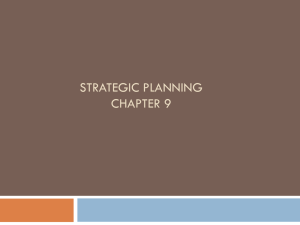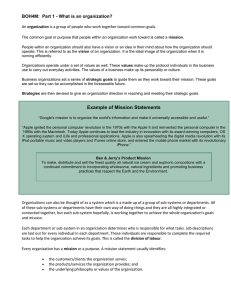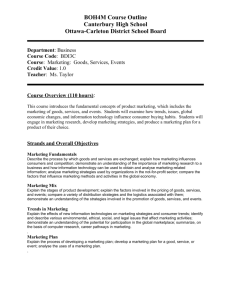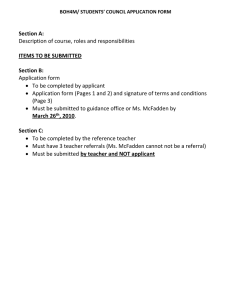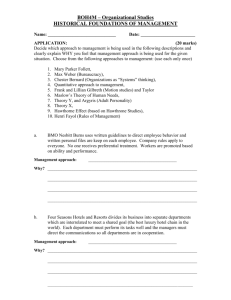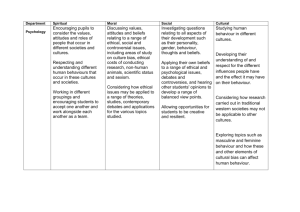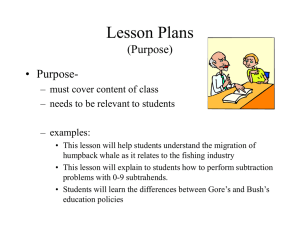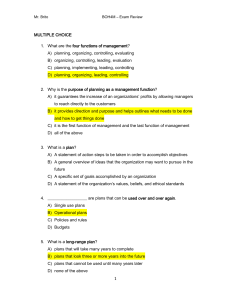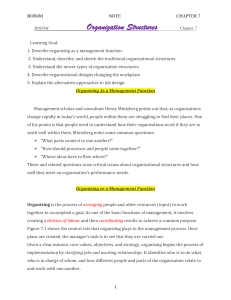Cloze Student Notes ch 9 wittmann
advertisement
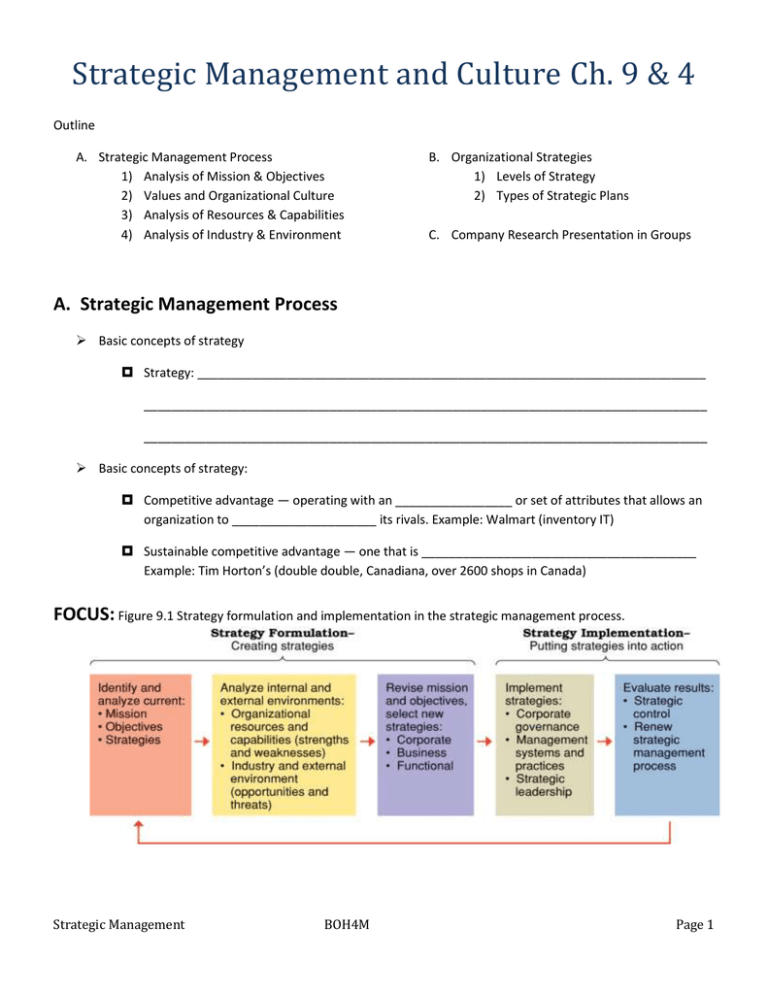
Strategic Management and Culture Ch. 9 & 4 Outline A. Strategic Management Process 1) Analysis of Mission & Objectives 2) Values and Organizational Culture 3) Analysis of Resources & Capabilities 4) Analysis of Industry & Environment B. Organizational Strategies 1) Levels of Strategy 2) Types of Strategic Plans C. Company Research Presentation in Groups A. Strategic Management Process Basic concepts of strategy Strategy: __________________________________________________________________________ __________________________________________________________________________________ __________________________________________________________________________________ Basic concepts of strategy: Competitive advantage — operating with an _________________ or set of attributes that allows an organization to _____________________ its rivals. Example: Walmart (inventory IT) Sustainable competitive advantage — one that is ________________________________________ Example: Tim Horton’s (double double, Canadiana, over 2600 shops in Canada) FOCUS: Figure 9.1 Strategy formulation and implementation in the strategic management process. Strategic Management BOH4M Page 1 Strategic questions for strategy formulation: What is our business __________________________? Who are our ______________________? What do our customers consider ______________________? What have been our __________________________? What is our __________________? A1) Analysis of Mission: The ________________ for an organization’s existence. Good mission statements identify: Customers Products and/or services Location Underlying philosophy An important _____________ of the mission is how well it serves the _________________________. Figure 9.2 How external stakeholders can be valued as strategic constituencies of organizations. A1) Analysis of Objectives: o o Operating objectives direct activities toward key and specific performance results. Typical operating objectives (fill in using page 232): Profitability Market share Human talent Financial health Cost efficiency Product quality Innovation Social responsibility Strategic Management BOH4M Page 2 A2) Analysis of Values and Organizational Culture: Values are broad _______________ about what is or is not ______________________________. Strong core values for an organization helps build ______________________________________, gives __________________ to an organization, and it ___________________ the mission statement. Organizational culture ___________________ the dominant ______________________________ of the organization as a whole. Organizational Culture Definition: The system of shared beliefs and values that develops within an organization and guides the behaviour of its members. Sometimes called ____________________________. It is the key aspect of any organization and work setting. It is “the way we do things here” Shapes the ______________ of managers and other organization members. Points people in common _________________________. Helps build institutional identity. Gives character to the organization in the eyes of _________________________________________. Backs up the mission statement. Guides the _________________ of organizational members in meaningful and _____________ ways. Strong cultures: _________________ members to do things that are in the best interests of the organization. _____________________ dysfunctional work behaviour. Encourage ________________________________________________________________________. The best organizations have strong cultures that: Are ____________________________________. Emphasize ___________________. _____________ for risk taking. Encourage _________________________. Value the _______________________________. 2 Levels of Organizational Culture ___________ Culture - Underlying assumptions and beliefs that influence behaviour and contribute to the observable culture. _______________________ Culture - What one sees and hears when walking around an organization. Figure 4.4 p. 101 Levels of Organizational Culture Observable Culture and Core Culture. Strategic Management BOH4M Page 3 What is observable culture? What one sees and hears when walking around an organization. Elements of observable culture: _________________ – tales of events conveying core values __________________ – people (past & Present) who display core values ___________________________ – celebration of people and events that display core values ____________________ – language or symbols conveying core values What is the core culture? Underlying assumptions and beliefs that influence behaviour & contribute to the observable culture. Core culture and values: Strong cultures have a _______________________________________________________________. ____________________________ to core values is a key to long-term success. Important cultural values include: Performance excellence __________________ Worker involvement Innovation _____________________ Integrity _________________________ Figure 9.3 p. 233 SWOT analysis of strengths, weaknesses, opportunities, and threats. Strategic Management BOH4M Page 4 A3) Analysis of Organizational Resources & Capabilities: (with Fig 9.3 above) INTERNAL analysis of Strengths and Weaknesses Important goal of assessing core competencies. Potential core competencies: Special knowledge or expertise. _________________________________________________ Efficient manufacturing approaches. ____________________________________________________________________. A4) Analysis of Industry and Environment: (with Fig 9.3 above) EXTERNAL analysis of Opportunities and Threats Assessment of macro environment: Technology. ___________________________. Social structures & population demographics. ____________________________ Natural environment. Analysis of industry environment: Resource suppliers. ______________________. ______________________. Figure 9.4 Porter’s model of five strategic forces affecting industry competition. Strategic forces to be _____________________ in conducting an industry analysis. ___________________________________, New entrants, ____________________, Buyers, ________________________________. Helps determine if the industry is ____________________ or ______________________. Strategic Management BOH4M Page 5
